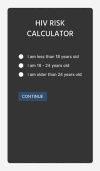Developing a youth-friendly internet-enabled HIV risk calculator: A collaborative approach with young key populations, living in Soweto, South Africa
- PMID: 39888949
- PMCID: PMC11785273
- DOI: 10.1371/journal.pdig.0000672
Developing a youth-friendly internet-enabled HIV risk calculator: A collaborative approach with young key populations, living in Soweto, South Africa
Abstract
Although South Africa is the global epicenter of the HIV epidemic, the uptake of HIV testing and treatment among young people remains low. Concerns about confidentiality impede the utilization of HIV prevention services, which signals the need for discrete HIV prevention measures that leverage youth-friendly platforms. This paper describes the process of developing a youth-friendly internet-enabled HIV risk calculator in collaboration with young people, including young key populations aged between 18 and 24 years old. Using qualitative research, we conducted an exploratory study with 40 young people including young key population (lesbian, gay, bisexual, transgender (LGBT) individuals, men who have sex with men (MSM), and female sex workers). Eligible participants were young people aged between 18-24 years old and living in Soweto. Data was collected through two peer group discussions with young people aged 18-24 years, a once-off group discussion with the [Name of clinic removed for confidentiality] adolescent community advisory board members and once off face-to-face in-depth interviews with young key population groups: LGBT individuals, MSM, and female sex workers. LGBT individuals are identified as key populations because they face increased vulnerability to HIV/AIDS and other health risks due to societal stigma, discrimination, and obstacles in accessing healthcare and support services. The measures used to collect data included a socio-demographic questionnaire, a questionnaire on mobile phone usage, an HIV and STI risk assessment questionnaire, and a semi-structured interview guide. Framework analysis was used to analyse qualitative data through a qualitative data analysis software called NVivo. Descriptive statistics were summarized using SPSS for participant socio-demographics and mobile phone usage. Of the 40 enrolled participants, 58% were male, the median age was 20 (interquartile range 19-22.75), and 86% had access to the internet. Participants' recommendations were considered in developing the HIV risk calculator. They indicated a preference for an easy-to-use, interactive, real-time assessment offering discrete and private means to self-assess HIV risk. In addition to providing feedback on the language and wording of the risk assessment tool, participants recommended creating a colorful, interactive and informational app. A collaborative and user-driven process is crucial for designing and developing HIV prevention tools for targeted groups. Participants emphasized that privacy, confidentiality, and ease of use contribute to the acceptability and willingness to use internet-enabled HIV prevention methods.
Copyright: © 2025 Mulaudzi et al. This is an open access article distributed under the terms of the Creative Commons Attribution License, which permits unrestricted use, distribution, and reproduction in any medium, provided the original author and source are credited.
Conflict of interest statement
The authors have declared that no competing interests exist.
Figures
References
-
- UNAIDS. HIV and AIDS Estimates -South Africa [Internet]. 2022 [cited 2023 Aug 20]. Available from://www.unaids.org/en/regionscountries/countries/southafrica
-
- Simbayi LC, Zuma K, Zungu N, Moyo S, Marinda E, Jooste S, Mabaso M, Ramlagan S, North A, van Zyl J, Mohlabane N, Dietrich C NI and the SVT (2019). South African National HIV Prevalence, Incidence, Behaviour and Communication Survey, 2017 [Internet]. Cape Town, South Africa; 2019. Available from: https://www.hsrcpress.ac.za/books/south-african-national-hiv-prevalence-...
-
- Shisana O, Risher K, Celentano DD, Zungu N, Rehle T, Ngcaweni B, et al.. Does marital status matter in an HIV hyperendemic country? Findings from the 2012 South African National HIV Prevalence, Incidence and Behaviour Survey. AIDS Care—Psychological and Socio-Medical Aspects of AIDS/HIV. 2016;28(2). - PMC - PubMed
Grants and funding
LinkOut - more resources
Full Text Sources





